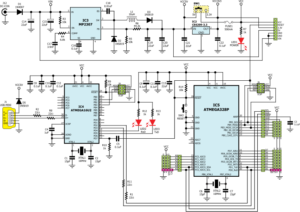 Contents
Contents
- Lean, Free Scaled Agile
- Lower Agile Costs
- Agile vs. agile
- Applying Systems Thinking to Agile
- Evidence of Success
Lean, Free Scaled Agile
There are several well-known methods of scaled Agile for multi-team, multi-iteration programs. Why use FuSca™ instead? Because Full Scale agile™ was invented to address problems with popular methods. The system rejects the concept of “seagull” consultants, flying in to drop their poop and then flying off. The site is set up so that current employees in your organization can do the training and coaching required. It is modeled on the concept of “open source” software. All of the steps for implementing it are on this site, and all content can be copied and modified freely under the GNU Free Documentation License with attribution. There are no certifications, high-cost seminars, conferences, or training events.
More specifically:
-

The GNU Logo Full Scale agile is free, licensed the same way open-source software is. All of the background information, specific steps, and forms you need to implement it with a single team, a startup, multi-team programs, or an entire enterprise are on this Web site.
- Self-serving consultants and companies have misled employers into hiring more people and spending more training money than necessary to implement scaled Agile. With FuSca you don’t hire Scrum Masters, release facilitators, or Agile project managers, or waste productive time by making people sit through days of training. (Bringing in a mob of outsiders also increases resistance to change, as noted in the Pillars of Radical agile.)
- The majority of scaled Agile methods are software-centric and/or assume the ability to deliver output to customers each sprint; Full Scale agile will work for any type of project facing significant unknowns.
- “Agile” methods are not just different ways of managing work: they are the current term of art for progressive management techniques executives have resisted for decades, despite overwhelming evidence of their benefits for customers, workers, and long-term financials. Some scaled Agile systems subvert agility by telling executives what they want to hear or pushing fictions to make money.
- For example, Full Scale agile rejects the “Waterfall Myth” that human beings can predict the future, especially in research and development (R&D) or new product development (NPD) projects with high levels of “unknowns”:
- In its Project Management Body of Knowledge (PMBOK), the Project Management Institute states firmly that changes to a project plan will result from execution of the project.
- Every waterfall project manager is taught how to “rebaseline” a plan, providing new date, scope, and/or budget expectations as new information arrives.
- Executives have (often purposely) misunderstood project plans as commitments, rather than initial views based on what we know today that will change.
- The Agile Manifesto shifted the focus of project management from predicting the future to state in its First Principle, “Our highest priority is to satisfy the customer…”
- The creators of the most popular Agile methods got a few things wrong about human psychology, and did not cover everything a team needs to succeed, according to my review of more than 600 studies and other sources on small group dynamics for a teamwork book I wrote called The SuddenTeams™ Program (described on the next page). So Full Scale agile modifies or adds some practices based on that research.
Lower Agile Costs
One distinction of FuSca is reduced operating costs compared to other Agile frameworks. This is primarily achieved by not making you hire additional people just to implement Agile:
| Other Frameworks |
Typical Cost | FuSca Cost |
| Up to 1 FT Scrum Master per team | ~$100,000/yr each (Note 1) | $0 (Note 2) |
| Additional Agile coaches | ~$160,000/yr each | $0 (Note 3) |
| Classroom training fee (1 week) | $5,000 | $0 |
| Classroom time for employees | 24-40 hours each | 2 hours each |
| Scrum of scrums | 1.25 hours/wk per Scrum Master and PO |
0 |
Notes:
- Example total compensation in 2021, including benefits, but not including agency fees if a contract worker.
- A small percentage of working time is required from current personnel filling the role—typically less than 10% of the individual’s time above what they would be spending in team meetings anyway.
- In larger organizations, current personnel may be converted out of redundant positions to serve in the role of Agile Release Manager, which includes cross-team coaching duties.
Agile vs. agile
As defined on the Philosophy page, I differentiate between methods based on the Agile Manifesto (“Agile”) and the broader approach of agility (“agile”). I became convinced while writing an evidence-based training program on teamwork that most of what managers do is based on traditions going back millennia… not what would work better if they harnessed how the human brain works, alone and in groups. Agile is merely the most recognized word today for a collection of progressive management practices proven effective both by scientists and by open-minded executives in unusual companies over the past 100 years.
I prefer agility over Agile. This website has sections telling you how to put it in place, leveraging concepts of self-directed work teams and corporate democracy.
However, most executives are not willing to adopt those unusual practices, no matter how much evidence there is these work better for almost everyone (see examples below). Some people are scared to go that far outside their comfort zone. If their organizations are succeeding well enough against others operating within the typical management paradigms, that’s good enough for them. However, an unfortunate number of managers are simply unwilling to give up the degree of control they have gained over others—their “social power“—required to enact true agility.
Fortunately, many have begun to warm to upper-case “Agile” practices, at least at the lower levels of the company. That’s why I provide versions of Kanban and Scrum as well, customized based on research data and repeated experiences.
Applying Systems Thinking to Agile
 Evidence from scientific research, business failures, politics, military history and sports has proven over and over that a disciplined, systematic approach to achieving a goal has a greater chance of success. That is, any systematic approach to fixing a problem is better than none. Even in the case of self-governing organizations, the great paradox is that you can’t just say, “Poof, you’re a self-directed work team. Go be great!” Our approach to Self-Directed agile provides a method for directing a team’s energies efficiently as it creates its own processes.
Evidence from scientific research, business failures, politics, military history and sports has proven over and over that a disciplined, systematic approach to achieving a goal has a greater chance of success. That is, any systematic approach to fixing a problem is better than none. Even in the case of self-governing organizations, the great paradox is that you can’t just say, “Poof, you’re a self-directed work team. Go be great!” Our approach to Self-Directed agile provides a method for directing a team’s energies efficiently as it creates its own processes.
For capital-A Agile, FuSca initially enforces a system proven successful in multiple companies, the way a sports coach requires a team to follow orders until it knows the system well enough to improvise. But this system emphasizes team empowerment over time far more than competing systems do. Notice this emphasis in these key differences between FuSca and the way Agile (Scrum or Kanban) is often practiced:
- The Agile Performance Standards for short-term predictability, quality, accountability, and customer satisfaction.
- Maximized self-organization, in the form of self-directed work teams that rotate the Facilitator role, replacing the team leader or Scrum Master (also because that term may be troubling to some people).
- The part-time nature of the Product Owner and Facilitator roles in Scrum (see “Guidance Roles”).
- Extreme transparency through open meetings (“Scrum Ceremonies“), work trackers visible to all stakeholders (“Choose a Tracker“), and open-source training content and tools.
- Backlog and user story grooming in Scrum by the entire team working together (“Groom Stories”).
- Creation of task lists prior to the sprint start (“Take Them to Task“).
- No story points required: FuSca relies on labor-hour estimation at the task level for story sizing initially, only if needed to prevent overcommitment, and story or epic counts for longer-term prediction if executives insist on that (see “Why use story counts instead of story points?“).
Note: Organizations already using points and able to meet the Agile Performance Standards are welcome to keep using points. - “Just enough, just in time” architecture documentation.
- Strict discipline around:
- Team membership (see “The Power of Stability“).
- Not accepting scope increases between iteration boundaries, except in true emergencies (per “Toe the Goal Line“).
- Mandatory meeting attendance for team members.
- Initial implementation of the full system as described.
- Freedom of teams to revise or abandon most of the system once, and as long as, the Standards are met.
Evidence of Success
 This system evolved through work at Los Alamos National Laboratory, Microsoft, Honeywell, Red Hat, NetApp, and many smaller firms. Metrics from those engagements include:
This system evolved through work at Los Alamos National Laboratory, Microsoft, Honeywell, Red Hat, NetApp, and many smaller firms. Metrics from those engagements include:
- Predictability across a unit’s cross-functional Scrum teams achieved the 84th percentile among all companies using Rally in less than a year.
- The system achieved quarterly release predictability above 90% consistently while helping to reduce the defect backlog to net zero.
- In the first sprint after taking over as Scrum Master, I helped a team deliver 100% of its committed stories for the first time, and it continued to do so in most subsequent sprints.
- An Agile tool selected using the disciplined approach described under “Customize FuSca” was estimated to realize a minimum 282% annual return on investment, convincing the software organization to switch despite initial resistance.
- In the first contract in which I served as trainer and Scrum Master for four teams simultaneously, three of the four achieved 100% story acceptance within their first four sprints, with the fourth at 97% by contract end.
- Three teams navigated major personnel changes due to a reduction in force with little measurable impact on productivity.
- User-story acceptance rates rose by more than 50% in the first sprints managed by the approach at one company.
- One team adjusted to a change in scope of 119 initial stories due in three months (per a company-wide waterfall project plan) and delivered on time without overtime.
- At Los Alamos:
- Self-directed work teams were chiefly responsible for a rise in the Lab’s property management ratings by outside auditors from 45 (out of 100) to 87 in just two years.
- After four months as a self-directed team, three technical communicators were doing as much work as the group had done before with five people—including a team leader—yet reported no sense of overload.
As mentioned in the previous section, FuSca is built on a foundation of self-directed work teams, groups without team leaders or managers involved in their daily operations. Here are a few success examples I came across while developing The SuddenTeams Program:
- At a Green Giant plant in Illinois, a line-employee team reduced average machine changeover time by more than half, realizing $793,000 in downtime and inventory savings.
- A Quaker Oats team formed with union assistance rescued a plant in Illinois from probable closure and went on to achieve recognition as an “America’s Best Plant.”
- A team of “petroleum engineers from Amoco… cut its time to forecast remaining oil and gas reserves from 119 person-days to 29 person-days; a test and assembly team from Texas Instruments… reduced its manufacturing cycle time 42 percent on one of the company’s major products” (from Breakthrough Teamwork by D. Romig).
- The graphics department in Palm Beach County (FL) formed a self-directed team by splitting half of the former supervisor’s pay among the team members in exchange for taking over the supervisor’s duties. Within a year the team created a 21% increase in revenues—while saving the taxpayers the other half of the supervisor’s pay!
- A self-directed team at Tektronix was able to produce in just three days the same number of units formerly produced in 14.
- In the six months after a switch to self-directed work teams, the package delivery group at Los Alamos increased same-day deliveries to partial addresses by 186%; decreased total incorrect deliveries by 68%; and reduced sick-leave absences by 43%.
- As reported in a PBS series called “Learning in America,” faculty members were teamed with principals or students to turn around four poor-performing schools around the country with disadvantaged student populations. Sample results from different schools include:
- Attendance rising from chronically low to a rate of 98 percent.
- Sixth-grade standardized scores going from the 44th percentile to the 97th.
- The percentage of students scoring at or above grade level in math growing from only half to more than 90 percent.
- A General Electric plant in North Carolina ran “without supervisors” and “reduced costs by more than 30 percent, shortened delivery cycles from three weeks to three days, and reduced customer complaints by a factor of ten” (from The Wisdom of Teams by J. Katzenbach and D. Smith).
↑ About FuSca | ← How to Use | → Full Scale Philosophy
